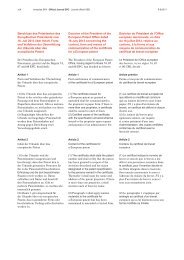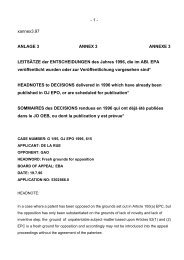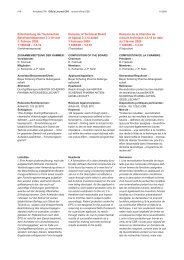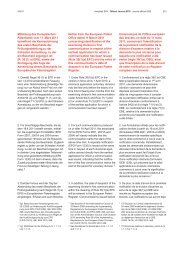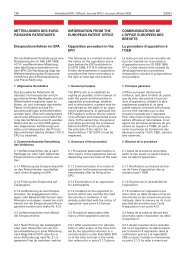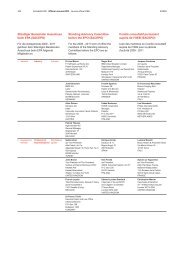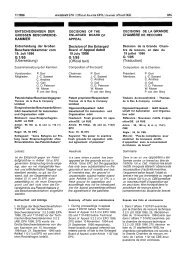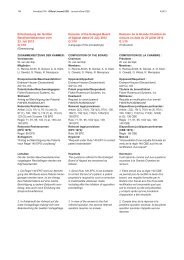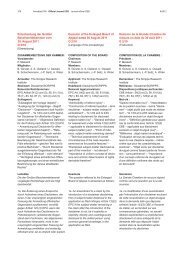Sonderausgabe 1 - European Patent Office
Sonderausgabe 1 - European Patent Office
Sonderausgabe 1 - European Patent Office
You also want an ePaper? Increase the reach of your titles
YUMPU automatically turns print PDFs into web optimized ePapers that Google loves.
2007 <strong>Sonderausgabe</strong> Nr. 1 ABl. EPA / Special edition No. 1 OJ EPO / Edition spéciale n° 1 JO OEB 59<br />
SECHSTER TEIL<br />
BESCHWERDEVERFAHREN<br />
Artikel 106<br />
Beschwerdefähige Entscheidungen<br />
(1) Die Entscheidungen der Eingangsstelle,<br />
der Prüfungsabteilungen, der<br />
Einspruchsabteilungen und der Rechtsabteilung<br />
sind mit der Beschwerde<br />
anfechtbar. Die Beschwerde hat<br />
aufschiebende Wirkung.<br />
(2) Eine Entscheidung, die ein Verfahren<br />
gegenüber einem Beteiligten nicht<br />
abschließt, ist nur zusammen mit der<br />
Endentscheidung anfechtbar, sofern<br />
nicht in der Entscheidung die gesonderte<br />
Beschwerde zugelassen ist.<br />
(3) Das Recht, Beschwerde gegen<br />
Entscheidungen über die Kostenverteilung<br />
oder Kostenfestsetzung im<br />
Einspruchsverfahren einzulegen, kann in<br />
der Ausführungsordnung eingeschränkt<br />
werden.<br />
Artikel 107<br />
Beschwerdeberechtigte und Verfahrensbeteiligte<br />
Jeder Verfahrensbeteiligte, der durch<br />
eine Entscheidung beschwert ist, kann<br />
Beschwerde einlegen. Die übrigen<br />
Verfahrensbeteiligten sind am<br />
Beschwerdeverfahren beteiligt.<br />
Artikel 108<br />
Frist und Form<br />
Die Beschwerde ist nach Maßgabe der<br />
Ausführungsordnung innerhalb von zwei<br />
Monaten nach Zustellung der Entscheidung<br />
beim Europäischen <strong>Patent</strong>amt<br />
einzulegen. Die Beschwerde gilt erst als<br />
eingelegt, wenn die Beschwerdegebühr<br />
entrichtet worden ist. Innerhalb von vier<br />
Monaten nach Zustellung der Entscheidung<br />
ist die Beschwerde nach Maßgabe<br />
der Ausführungsordnung zu begründen.<br />
Artikel 109<br />
Abhilfe<br />
(1) Erachtet das Organ, dessen<br />
Entscheidung angefochten wird, die<br />
Beschwerde für zulässig und begründet,<br />
so hat es ihr abzuhelfen. Dies gilt nicht,<br />
wenn dem Beschwerdeführer ein<br />
anderer an dem Verfahren Beteiligter<br />
gegenübersteht.<br />
(2) Wird der Beschwerde innerhalb von<br />
drei Monaten nach Eingang der Begründung<br />
nicht abgeholfen, so ist sie unverzüglich<br />
ohne sachliche Stellungnahme<br />
der Beschwerdekammer vorzulegen.<br />
PART VI<br />
APPEALS PROCEDURE<br />
Article 106<br />
Decisions subject to appeal<br />
(1) An appeal shall lie from decisions of<br />
the Receiving Section, Examining Divisions,<br />
Opposition Divisions and the<br />
Legal Division. It shall have suspensive<br />
effect.<br />
(2) A decision which does not terminate<br />
proceedings as regards one of the<br />
parties can only be appealed together<br />
with the final decision, unless the decision<br />
allows a separate appeal.<br />
(3) The right to file an appeal against<br />
decisions relating to the apportionment<br />
or fixing of costs in opposition proceedings<br />
may be restricted in the Implementing<br />
Regulations.<br />
Article 107<br />
Persons entitled to appeal and to be<br />
parties to appeal proceedings<br />
Any party to proceedings adversely<br />
affected by a decision may appeal. Any<br />
other parties to the proceedings shall be<br />
parties to the appeal proceedings as of<br />
right.<br />
Article 108<br />
Time limit and form<br />
Notice of appeal shall be filed, in accordance<br />
with the Implementing Regulations,<br />
at the <strong>European</strong> <strong>Patent</strong> <strong>Office</strong> within two<br />
months of notification of the decision.<br />
Notice of appeal shall not be deemed to<br />
have been filed until the fee for appeal<br />
has been paid. Within four months of<br />
notification of the decision, a statement<br />
setting out the grounds of appeal shall<br />
be filed in accordance with the Implementing<br />
Regulations.<br />
Article 109<br />
Interlocutory revision<br />
(1) If the department whose decision is<br />
contested considers the appeal to be<br />
admissible and well founded, it shall<br />
rectify its decision. This shall not apply<br />
where the appellant is opposed by<br />
another party to the proceedings.<br />
(2) If the appeal is not allowed within<br />
three months of receipt of the statement<br />
of grounds, it shall be remitted to the<br />
Board of Appeal without delay, and<br />
without comment as to its merit.<br />
SIXIEME PARTIE<br />
PROCEDURE DE RECOURS<br />
Article 106<br />
Décisions susceptibles de recours<br />
(1) Les décisions de la section de dépôt,<br />
des divisions d’examen, des divisions<br />
d’opposition et de la division juridique<br />
sont susceptibles de recours. Le recours<br />
a un effet suspensif.<br />
(2) Une décision qui ne met pas fin à<br />
uneprocédureàl’égard d’une des<br />
parties ne peut faire l’objet d’un recours<br />
qu’avec la décision finale, à moins que<br />
ladite décision ne prévoie un recours<br />
indépendant.<br />
(3) Le droit de former recours contre des<br />
décisions portant sur la répartition ou la<br />
fixation des frais de la procédure d’opposition<br />
peut être limité dans le règlement<br />
d’exécution.<br />
Article 107<br />
Personnes admises à former le recours<br />
etàêtrepartiesàlaprocédure<br />
Toute partie à la procédure aux prétentions<br />
de laquelle une décision n’a pas<br />
fait droit peut former un recours contre<br />
cette décision. Les autres parties à ladite<br />
procédure sont de droit parties à la<br />
procédure de recours.<br />
Article 108<br />
Délai et forme<br />
Le recours doit être formé, conformément<br />
au règlement d’exécution, auprès<br />
de l’<strong>Office</strong> européen des brevets dans<br />
un délai de deux mois à compter de la<br />
signification de la décision. Le recours<br />
n’est réputé formé qu’après le paiement<br />
de la taxe de recours. Un mémoire<br />
exposant les motifs du recours doit être<br />
déposé dans un délai de quatre mois à<br />
compter de la signification de la décision,<br />
conformément au règlement<br />
d’exécution.<br />
Article 109<br />
Révision préjudicielle<br />
(1) Si l’instance dont la décision est attaquée<br />
considère le recours comme recevable<br />
et fondé, elle doit y faire droit.<br />
Cette disposition ne s’applique pas<br />
lorsque la procédure oppose le requérant<br />
à une autre partie.<br />
(2) S’il n’est pas fait droit au recours<br />
dans un délai de trois mois après réception<br />
du mémoire exposant les motifs, le<br />
recours doit être immédiatement déféré<br />
à la chambre de recours, sans avis sur<br />
le fond.



